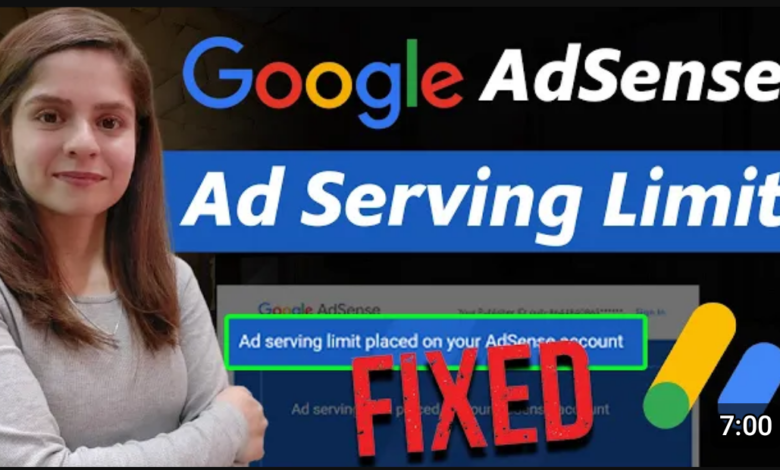Understanding Ad Limits on Your AdSense Account: Enhancing User Experience and Revenue Generation

Understanding Ad Limits on Your AdSense Account: Enhancing User Experience and Revenue Generation
Introduction:
In the dynamic world of online advertising, Google AdSense has become a trusted companion for website owners, bloggers, and content creators seeking to monetize their digital assets. However, as part of its commitment to ensuring a balanced user experience, Google has implemented ad limits to regulate the number of ads that can be displayed on a single page. In this blog post, we will delve into the reasons behind these ad limits, their benefits for both publishers and users, and how you can optimize your ad strategy to maintain a healthy revenue stream.

Why Ad Limits Exist:
- User Experience First: Ad limits are primarily in place to prioritize user experience. Overloading a webpage with ads can lead to slower load times, decreased overall site performance, and a cluttered appearance that may deter users from engaging with your content.
- Mobile Optimization: With the increasing prevalence of mobile browsing, maintaining a mobile-friendly site is crucial. Ad-heavy pages can negatively impact the mobile user experience, leading to higher bounce rates and fewer return visitors.
- Ad Relevance: Limiting the number of ads ensures that the ads displayed remain relevant to your content. An excessive number of ads could lead to a dilution of ad quality, resulting in decreased user engagement and click-through rates.
Benefits of Ad Limits:
- Improved Site Speed: By adhering to ad limits, you enhance your website’s loading speed, which is a critical factor in user retention. A faster website improves user satisfaction and encourages longer visits.
- Reduced Clutter: Fewer ads mean a cleaner and more organized layout, allowing users to focus on your content without distractions. This can lead to increased engagement and better retention rates.
- Higher Engagement: Ad limits promote the visibility of high-quality, relevant ads. This enhances the likelihood of users clicking on ads that genuinely interest them, resulting in better engagement and potentially higher earnings per click (EPC).
Optimizing Ad Strategy:
- Prioritize Ad Placement: Rather than focusing solely on the number of ads, prioritize strategic ad placement. Position ads where they are likely to generate the most clicks and maintain a seamless user experience.
- Ad Types and Sizes: Experiment with various ad formats and sizes to find the ones that blend seamlessly with your content and attract user attention without overwhelming them.
- Content Quality: Invest in high-quality, engaging content that keeps users on your site. The longer users stay, the more chances they have to interact with ads, increasing your revenue potential.
- Performance Monitoring: Regularly review your ad performance metrics through your AdSense dashboard. This will help you identify trends, understand which ads resonate with your audience, and make informed adjustments to your ad strategy.

Putting User Experience First: The Importance of Ad Limits on Your AdSense Account
In the bustling landscape of online advertising, achieving a harmonious balance between monetization and user satisfaction is paramount. Google AdSense, a widely trusted platform for website monetization, recognizes the significance of providing a positive user experience. This understanding has led to the implementation of ad limits, a measure designed to create a harmonious coexistence between revenue generation and user engagement. In this blog post, we will delve into the concept of putting user experience first, explore the rationale behind ad limits, and demonstrate how prioritizing user satisfaction can lead to sustainable success.
The Heart of User Experience:
- Navigational Ease: When users visit a website, they seek information or entertainment without hindrances. Ad limits ensure that advertisements do not dominate the layout, allowing users to navigate your content seamlessly and access the desired information effortlessly.
- Page Load Speed: A snappy website is a joy to interact with, but a cluttered page filled with ads can lead to slower loading times. Ad limits keep your website’s loading speed in check, enhancing user satisfaction by preventing frustrating delays.
The Balance Between Revenue and Experience:
- Engagement Overload: Placing too many ads on a page can overwhelm users, making it challenging for them to focus on your content. Ad limits prevent this overload, providing users with an uncluttered environment that encourages prolonged engagement.
- Ad Relevance: High-quality content deserves high-quality ads. Ad limits ensure that the ads displayed are relevant and resonate with your audience, enhancing their likelihood of clicking on the ads and benefiting your revenue in the long run.
Benefits of Prioritizing User Experience:
- Improved Retention: A website that respects users’ preferences and comfort is likely to retain visitors. Ad limits contribute to an environment where users want to spend more time, exploring your content and engaging with ads.
- Enhanced Brand Image: A user-friendly site sends a positive message about your brand. By respecting users’ experience, you establish trust and credibility, making visitors more likely to return and recommend your site to others.
- Long-Term Revenue Growth: While aggressive ad placements might yield short-term gains, they can harm your website’s reputation in the long run. Prioritizing user experience through ad limits can lead to sustained user engagement, ultimately resulting in higher click-through rates and better revenue prospects.
Strategies for User-Centric Ad Placement:
- Strategic Placement: Carefully choose ad placements that complement your content rather than overpower it. Ad limits encourage thoughtful positioning, ensuring that ads serve as valuable additions rather than distractions.
- Responsive Design: In the era of mobile browsing, responsive design is vital. Ad limits play a crucial role in maintaining a mobile-friendly site, contributing to a seamless user experience across devices.

Mobile Optimization and Ad Limits: Crafting a Seamless User Experience on Your AdSense Account
In today’s digitally connected world, where mobile devices have become an integral part of our lives, optimizing websites for mobile browsing is no longer an option—it’s a necessity. Google AdSense recognizes this shift and has introduced ad limits as a means to maintain a streamlined user experience across various devices. In this blog post, we’ll explore the importance of mobile optimization, how ad limits play a pivotal role in achieving it, and the strategies you can employ to create a mobile-friendly environment that maximizes both engagement and revenue.
Mobile-First Mindset:
- Dominance of Mobile Users: With a significant percentage of internet traffic originating from mobile devices, catering to mobile users is no longer an afterthought. Ad limits ensure that your website remains functional and engaging on smaller screens, encouraging mobile visitors to stay and explore.
- Responsive Design: Mobile optimization involves employing responsive design principles that adapt your website’s layout to fit various screen sizes. Ad limits contribute to this by preventing excessive ads that could hinder a seamless mobile experience.
The Role of Ad Limits in Mobile Optimization:
- Load Speed: Mobile users are particularly sensitive to load times. Ad limits help keep the number of ads in check, preventing performance bottlenecks that could lead to slow loading pages, frustrating mobile visitors, and increasing bounce rates.
- User-Friendly Layout: Mobile screens have limited space, making it crucial to present information in a concise and organized manner. Ad limits encourage careful ad placement, ensuring that ads don’t overcrowd the screen and disrupt the user’s journey.
Benefits of Mobile Optimization:
- Reduced Bounce Rates: A mobile-optimized site loads quickly and presents content in a digestible format. This results in lower bounce rates, as visitors are more likely to engage and explore when their experience is smooth and satisfying.
- Enhanced Engagement: Mobile users are on the go and seek quick, relevant information. Ad limits help maintain a clean layout that promotes easy navigation, encouraging users to interact with your content and ads more effectively.
- Cross-Device Consistency: A consistent experience across devices—from desktops to smartphones—creates a stronger brand presence. Mobile optimization, aided by ad limits, contributes to this consistency, ensuring that your site’s essence is preserved regardless of the device used.
Strategies for Effective Mobile Optimization:
- Mobile-Responsive Ads: Use ad formats that are designed specifically for mobile screens. These formats adapt to different screen sizes and orientations, providing a seamless experience.
- Testing and Monitoring: Regularly test your website’s mobile performance using tools like Google’s Mobile-Friendly Test. Monitor user behavior and engagement metrics to identify any potential issues and refine your mobile optimization strategy.

Ad Relevance: Elevating User Engagement and AdSense Revenue through Targeted Ads
In the ever-evolving landscape of online advertising, capturing the attention of your audience requires more than just quantity—it demands quality and relevance. Google AdSense, a prominent player in the advertising ecosystem, understands the importance of ad relevance. By prioritizing this aspect, AdSense not only enhances the user experience but also opens the door to higher click-through rates and increased revenue. In this blog post, we’ll explore the concept of ad relevance, why it matters, and how it can be leveraged to create a win-win scenario for both users and publishers.
The Significance of Ad Relevance:
- Enhanced User Experience: Relevant ads resonate with users’ interests and intentions, enriching their browsing experience. AdSense’s algorithms are designed to match ads to the content, ensuring that users encounter ads that align with their preferences and needs.
- Reduced Ad Fatigue: Irrelevant ads can lead to ad fatigue, where users become desensitized or annoyed by constant exposure to ads that have no relevance to them. AdSense’s emphasis on ad relevance helps prevent this, maintaining user engagement and preventing ad-related frustration.
The Role of AdSense in Ad Relevance:
- Contextual Matching: AdSense employs contextual matching algorithms to analyze your website’s content and display ads that are contextually relevant. This ensures that the displayed ads align with the topics your users are interested in.
- User Behavior Analysis: AdSense also takes into account users’ browsing behavior, interests, and demographics to deliver ads that are more likely to capture their attention. This personalized approach increases the likelihood of clicks.
Benefits of Prioritizing Ad Relevance:
- Higher Click-Through Rates (CTR): Ads that resonate with users are more likely to be clicked on. Ad relevance leads to increased CTR, which not only benefits advertisers but also boosts your AdSense revenue through higher EPC (earnings per click).
- Positive User Perception: When users encounter ads that match their interests, they perceive your website as valuable and credible. This enhances user trust and improves the overall perception of your content and ads.
- Long-Term Revenue Growth: A user who engages with relevant ads is more likely to return to your site and continue engaging with ads over time. This consistent engagement contributes to sustainable revenue growth.

Strategies for Maximizing Ad Relevance:
- High-Quality Content: Quality content serves as the foundation for ad relevance. When your content is well-crafted and valuable to your audience, AdSense’s algorithms can better match relevant ads to it.
- Continuous Monitoring: Regularly review the performance of ads on your site through your AdSense dashboard. Identify which ads are resonating with your audience and adjust your content strategy accordingly.
- Ad Placement: Thoughtful ad placement within your content can enhance relevance. Position ads near relevant sections of your content to increase the chances of users engaging with them.








hey
cool blog 🙂 will give it a follow and a like !
hey
lovely blog hope all is well
happy blogging.
Great Read Can i leave my thoughts ?! –
Thanks for reading , Love The Blog !!
Thanks – TheDogGod pomeranianpuppies.uk Thanks – Pomeranian Puppies & Adult Dog Guides & Tips http://pomeranianpuppies.uk
does cialis affect eye pressure tadalafilise.cyou/#
cialis 5 mg precio walmart cvs cialis 5mg price erectafil 40 mg